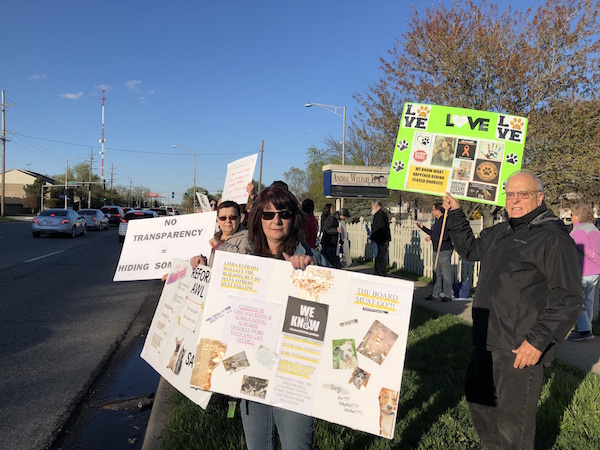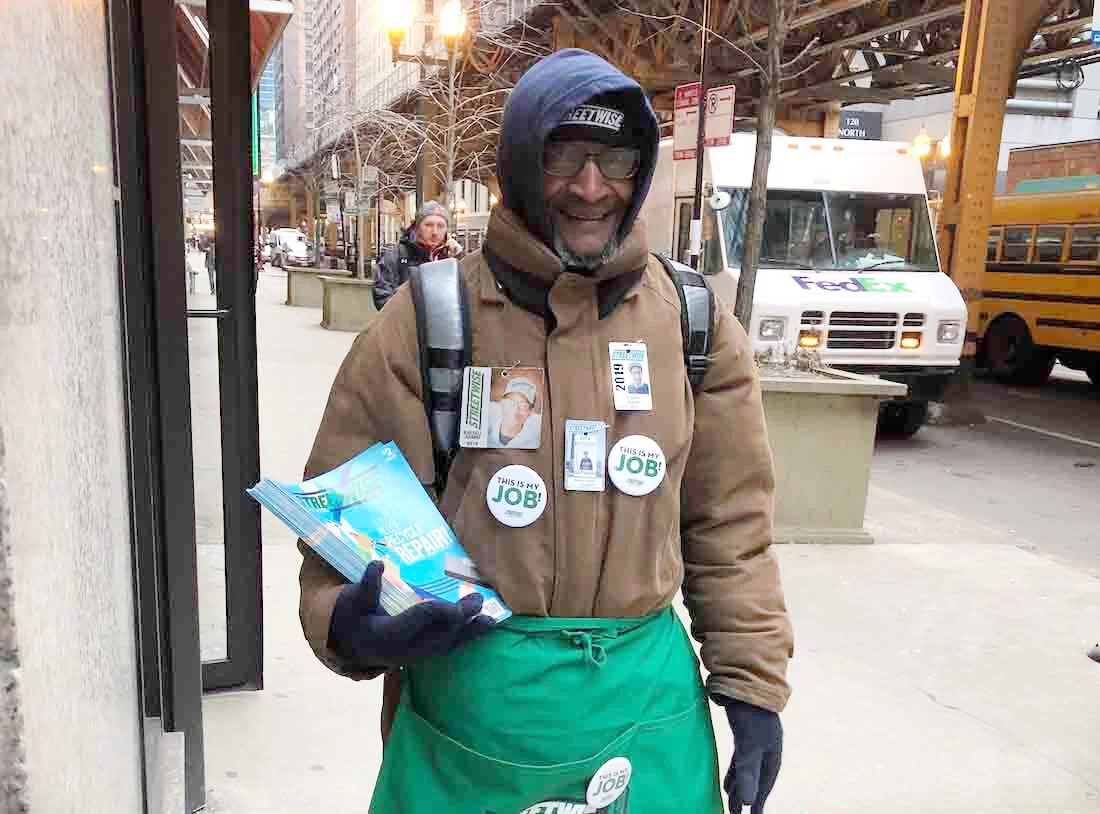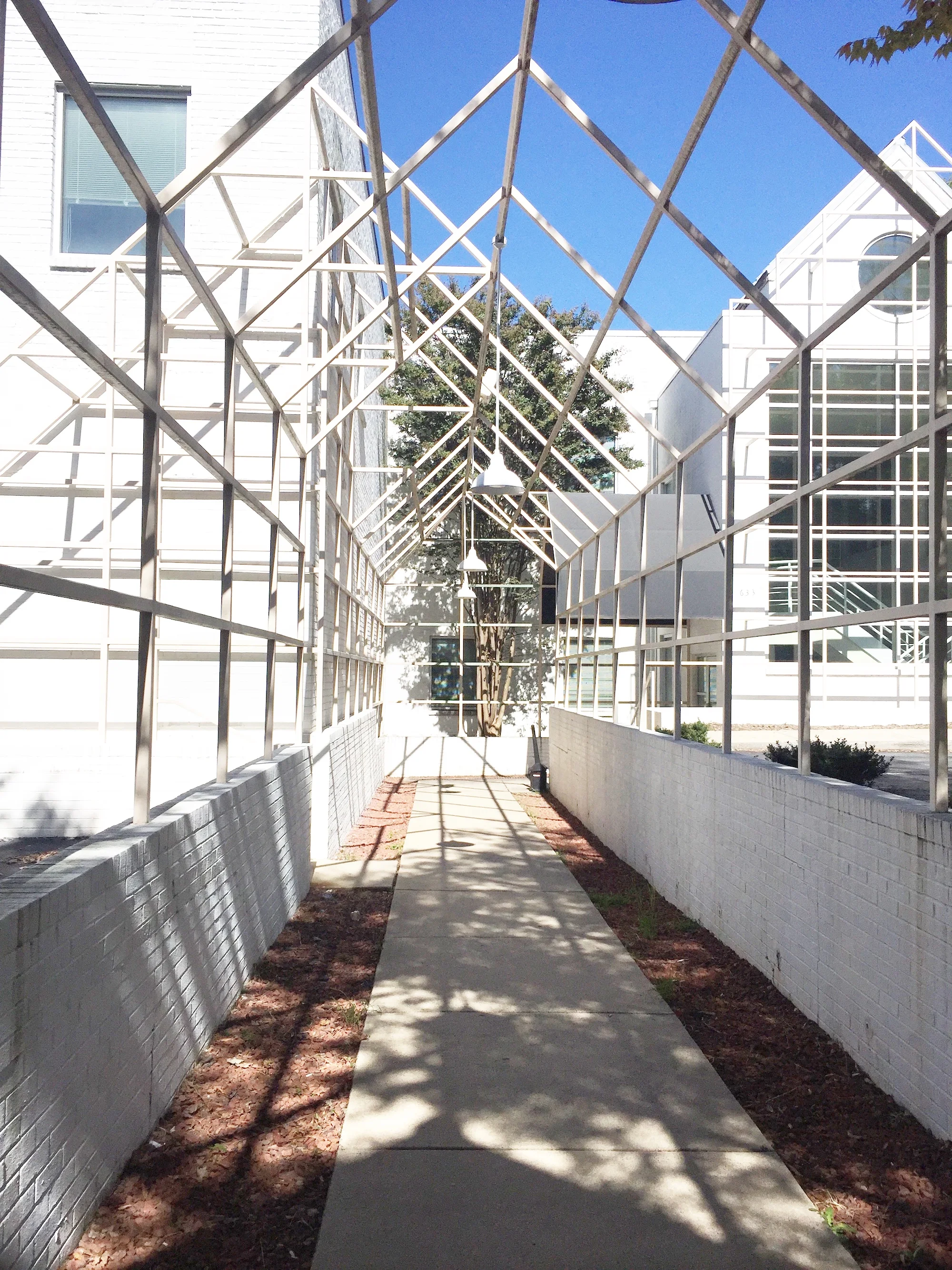A Furry Quandary
Dogs don’t need watches, but as the sky darkens outside the Anti-Cruelty Society in downtown Chicago, chow time is approaching and the dogs know it. The kennels are silent for a brief moment, the anticipation audible from scampering paws and visible in furiously wagging tails. The whimpers begin and then one dog leads the others into a jubilant cacophony of barks, yips and howls. The food is dispersed systematically by a volunteer, and the noise simmers to a low roar as the dogs scarf down their kibble, clanging their bowls softly against the metal bars of the kennels.
One of longer-term residents is a 5-year-old mixed breed named Cinnamon. Her story is common. Her owner had to move and couldn’t take Cinnamon with her. It was the last Wednesday in March when Cinnamon and her owner took a trip to the River North area in downtown Chicago. The temperature was a crisp 55 degrees and the sun was pushing its way through the clouds. Cinnamon would have been wearing her toothy grin as they walked through the glass doors of the Anti-Cruelty Society. Her owner would have sat in an intake room with Cinnamon who was likely frantic with the scent of so many different animals. A staff member would have played with Cinnamon while working with her owner to build a profile and get any medical information. She would have received her vaccines, deworming paste and been scanned for a microchip. After all of the intake procedures were finished, the staffer would have tried to comfort Cinnamon while her owner slipped out the door. During her first week in the shelter, Cinnamon developed kennel cough which is not unusual. Animals under extreme stress have weakened immune systems and entering a shelter is a disorienting and stressful process.
Cinnamon plays outside the Anti-Cruelty Society in Chicago.
Walking past her kennel, you wouldn’t know she’s been at the Anti-Cruelty Society for almost two months. Her tail wiggles with such enthusiasm it sends vibrations across her petite frame. Her spice-colored fur meets patches of grey around her snout and eyes, her face expressing equal parts curiosity and hesitation. She prances in circles around her kennel and stamps her paws, perhaps hoping to be noticed and taken home by a visitor. Cinnamon is fortunate for landing at this shelter. As an adoptable healthy dog, she doesn’t face the risk of euthanasia at this no-kill shelter. Not all shelter animals are this lucky, and their fate is directly caused by what’s happening in surrounding communities.
Responsible pet ownership has steadily risen in many communities, but gaps remain. Eighty-seven percent of the estimated 23 million cats and dogs living in underserved communities are not spayed or neutered, according to the Animal Sheltering database. Their offspring join the 6 to 8 million animals entering shelters every year, and three million of those never leave.
There are over 3,500 shelters in the U.S. and over 10,000 rescue organizations in North America charged with the placement and wellbeing of animals. These shelters are supposed to maintain specific standards to create a healthy and safe environment for the animals in their care. These guidelines are laid out clearly by the American Society for the Prevention of Cruelty for Animals, the ASPCA. The standards include items such as “minimum sanitation standards, expansion of live release rate and adoption, returning lost pets to their owners quickly and reliably, being transparent in shelter practices and minimizing euthanasia through procedural safeguards.” While many shelters are working to create partnerships and programming to ensure the best outcomes for the animals in their charge, some shelters are faltering. These failures lead to unnecessary euthanasia.
Euthanasia practices can be controversial because it’s sad to see animals die prematurely, but these practices have actually become widely humane over time. All shelters, “kill” and “no-kill” alike, practice merciful euthanasia to put animals to rest whose injuries would negatively impact their quality of life and whose demeanor would make them unadoptable. These cases make up around a third of the animals who are put to sleep each year. At the more troubling end of this practice lie shelters which can’t keep up with their intake rates, and are forced to euthanize animals to make room for their incoming replacements. These lives make up the other 2.4 million lost annually and they belong to healthy, adoptable animals.
At Chicago Animal Care and Control in the Pilsen neighborhood, these words are painted across the wall behind the front desk: “The greatness of a nation and its moral progress can be judged by the way its animals are treated. - Mahatma Gandhi.” Two rooms over, longtime Chicago resident Liz Lewandowski walks down a row of kennels, acknowledging each dog. “It starts with overpopulation,” Lewandowski, 58, says. “My older sister once told me, children don’t ask to come into the world and animals don’t ask to come into the world.” She says her heart cries when she thinks about all of the injustices animals are put through. “These animals have a bad start to life, sometimes they get adopted and returned and adopted and returned. How many times are we going to fail these animals?” She isn’t alone in this sentiment. Other animal welfare advocates such as the People for the Ethical Treatment of Animals or ‘PETA’, acknowledge that there will never be enough homes for all the animals born in the U.S. They attribute euthanasia as a tragic necessity caused by those who “refuse to spay and neuter their animals, who abandon animals when they grow tired of them and who patronize pet shops instead of adopting stray or shelter animals.”
Animal welfare presents an interesting dichotomy in society because individual pets are often showered with the same concern and affection as family members, but it can be hard to multiply that affection for every animal in every shelter across the country. So, how can an individual make a difference that will help the mass?
Just over 15 miles southwest of Chicago in Bridgeview, Shay Nemecek has figured it out. She took the leap from pet owner to animal advocate in 2017 when cases of abuse and neglect appeared on her social media and made her aware of what was happening in shelters across the country. “You might hear something here and there,” Shay said, “but now the information is everywhere, and it’s in your face.” The Bridgeview, IL resident, 52, has worked in a small animal practice as a vet assistant for 34 years, but her work with animals doesn’t stop at the office. She currently owns and cares for two dogs, four cats, two parakeets and a guinea pig, and she noted this is actually the smallest number of dogs she’s had for many years.
Every morning, Shay gets up at 6:30 to scoop litter boxes, let the dogs out, feed her brood and get ready for work. During her shift, lasting anywhere from seven to ten hours, Shay bounces around the office doing everything from running heartworm tests to assisting with surgeries, including spays and neuters. Her clinic also provides vaccines and microchips. She frequently urges owners to microchip their pets so they don’t end up in the thick book of lost dogs and cats that Shay pages through regularly. “I’m all over those pages because when it comes down to it, it’s proof of ownership.” Shay says one of the best parts of her job is interacting with the people who love and care for their pets so much. Even when those pets “have to leave the physical world” she sees the compassion their owners show them until the bitter end. When she returns home each night, Shay lets the dogs out again, scoops more litter, and feeds the lot, which includes her daughters, 17 and 20, and her husband, Rich, 53. Shay also visits her mother, who suffers from rheumatoid arthritis, every other day to make her dinner and take her shopping. After dinner, you’ll find Shay at her computer, auburn hair falling at her shoulders, green eyes glued to the screen, blue polished nails scrolling through Lost Dogs Illinois—a website for lost dog reports—and scanning local shelter sites to see if she can find them. Recently, she matched a missing Yorkie from Lemont, IL, to one that was at the Animal Welfare League in Chicago Ridge, IL, and the family got the dog back. Shay’s hobby keeps her up until around 1 a.m. but she wouldn’t have it any other way. “Whenever I can, or if I hear of a missing animal in my neighborhood, I run out and try to help.” Shay frequently reposts lost dog pages, joins protests to spread awareness and educates people about spaying and neutering their pets, even at parties, because “some people just don’t know these things."
Her husband is supportive, but he doesn’t entirely share her passion for animal welfare. “This whole animal welfare thing,” Shay said, “he, …I almost feel sometimes he thinks I’m investing all this time and effort and nothing’s going to happen, maybe that nothing will ever change. He’s a little resigned.” But it’s clear Shay’s compassion has rubbed off on Rich, who recently found a loose dog at a construction site he was working, and got the dog back to its owner. He told his wife he would “be there in spirit,” when she attended a protest at the end of April for a group called Reform Animal Welfare League Chicago Ridge.
Shay Nemecek, center, stands with protestors outside the Animal Welfare League of Chicago Ridge.
Five miles south of Bridgeview, on Friday, April 26, 85 animal advocates and former Animal Welfare League volunteers and employees gathered along the narrow grassy space between Southwest Hwy in Chicago Ridge, IL, and a fence marking the boundaries of the shelter. Toting colorful picket signs with slogans such as “AWL, why are you not working with the rescue groups to save the animals in your shelter,” the group peacefully protested unsanitary conditions and negligent treatment of animals at the League.
Allegations of poor sanitation and harmful practices at this shelter have peppered media outlets in Chicago over the last year and the former director was dismissed from her role in May of 2018. In late January of 2019, the shelter ended their volunteer program. Without any advanced notice or explanation, volunteers who had worked for the shelter for upwards of 20 years were sent away. The Animal Welfare League could not be reached for comment. Per the website, adoptions are available Monday through Friday from 1 to 8 p.m. and Saturdays from 12 to 7 p.m. While the League’s board has vigorously denied the allegations, and even invited media crews to film inside, former volunteers and employees have spoken out against the organization.
One former employee, Crystal Broccardo, 34, quit her position at AWL in early January when employees were asked to sign non-disclosure agreements. “I was thinking, ‘Why are we signing this? What are they hiding?’” Broccardo started out volunteering when she was 13 and stayed with the shelter for 20 years. She transitioned into a staff role at age 20, working as an adoption supervisor, offsite coordinator and rescues coordinator. “[The board] was so close-minded to accepting help from outside sources. It seemed like they didn’t want to make it better for the dogs.” She disclosed the story of one dog she had grown fond of while working at the League. “I had someone interested in adopting [him] and a backup rescue lined up if the adoption fell through. I had noted this on his paperwork, in the computer and on his kennel. I had somewhere for this beautiful dog to go. One morning I couldn’t find him. They had euthanized him for being ‘food aggressive.’” He was coexisting with three other dogs in a garage before he was brought to the shelter and Broccardo used to feed him out of her hand. She believes he was euthanized to spite her. Broccardo is no longer allowed to enter the facility.
Her experience echoes many of the other testimonies shared at the protest. Former volunteer Jeannine Salerno said “the water bowls were always bone dry and the animals would be sitting in their own filth.” Kathy Bartosiak of Simply Shepherd Rescue detailed a time she found a German Shepherd that was struggling to breathe who had been at the League for more than a week. “It turned out he had a collapsed lung, and he ended up dying in his kennel because his other lung collapsed shortly after.”
The protestors received playful and supportive honks from cars, trucks and motorcycles. League officials and employees stood near the building’s front doors, keeping an eye on the protest and toting their own signs with slogans such as, “You don’t help. You hinder.” Broccardo doesn’t blame the employed staff for the issues surfacing within the shelter. “There are really good people that work there and they really do care. I hate when I see the employees of the shelter get attacked, because they are trying. I think the employees do their best and try their best. It’s the board that’s the problem,” she said.
The parking lot was barricaded at both openings, despite the shelter technically being open. At one point, a man pulled up in a sedan looking to adopt an animal, and the protestors cleared out of the way to let him through. John Fanning, an associate who works with the shelter, stopped the vehicle and sent the potential adopter away. Several of the protestors cried out to let him adopt an animal, and that he was not a part of the protest, but their cries were met with silence. Ald. Raymond Lopez of the 15th ward, was present and conversed with Fanning to see if the board’s President, Chris Higens would be willing to come outside and talk with the protestors to come to an understanding. His request was denied. Lopez has been an active participant in animal welfare initiatives since his election in 2015. “If we’re not going to have a dialogue to try and ensure that animals are being treated humanely,” Lopez said, “then obviously we’re at a stalemate and will continue doing what we do here.”
Nikki Ormsby, 29, is one of the founders of Reform Animal Welfare League Chicago Ridge and helped organized this protest. “I’ve been in the rescue community for about five years,” Ormsby said. “I work with over 20 shelters and rescues in the Midwest in several states. AWL has been on my radar for a couple years now, with the conditions and treatment of animals in that building. A friend of mine released the photos and videos of what was happening inside, and that’s when everything started unfolding.” The Wabash location of AWL has not received the same backlash because their director has actively worked with rescues to ensure the best outcomes for the animals in that shelter. The controversy around Chicago Ridge reflects how animals can be let down by this system.
This situation, seems to be the exception not the rule. While research indicates regional disparities with overcrowding, in the South and West particularly, overall trends show the number of animals entering and being euthanized in shelters has gone down in the last nine years, and adoptions have steadily increased, per ASPCA president Matt Bershadker. Institutions such as the Anti-Cruelty Society represent the growing number of shelters getting it right.
Back at the Anti-Cruelty Society, Community Programs Specialist Sarah Williams plays with Cinnamon in the shelter’s courtyard. They’ve bonded since Cinnamon’s arrival and her affection toward Williams is abundantly clear. Propped up on her black combat boots, Williams kneels on the ground, her pink and flower printed leggings resting on the concrete. Despite the ample room to dart around the outdoor area, Cinnamon hugs Williams’ knee, burying her snout into the nook of Williams’ arm and wagging her tail like a propeller. Williams looks down at Cinnamon, her short brown hair falling around her face and ice cream earrings dangling. She gently strokes her, kissing her head and cooing in a language familiar to anyone encountering a baby for the first time. Cinnamon takes the opportunity to whip her head up, almost knocking Williams’ plum-colored glasses off, to lick her face. Cinnamon’s personality has shone throughout her time at the shelter. She was recently added to the teen volunteer program and seems to enjoy the extra attention. During the three-week program, local teens were assigned to different cats and dogs to socialize them and get to know their personalities. In interacting with them, they can paint an honest picture for future adopters. For example, Cinnamon loves the rain. During a rainstorm, she amused the teens by hopping onto one of the green benches in the courtyard, rolling around and lapping up the rainwater. They also learned she is motivated by toys and loves belly rubs. This program is merely one of the initiatives the Anti-Cruelty Society has to improve the lives and outcomes of its residents.
Williams, 32, explains how the Society is tackling overcrowding on all fronts. The private shelter holds anywhere from 300 to 600 animals every season, including exotic animals. “We’re entering kitten season,” Williams says, citing the arrival of 50 kittens in January, 75 in February and 127 in March. There are about 30 to 40 million feral or “community” cats in the U.S., and despite only two percent of these not having been spayed or neutered, 80 percent of kittens born each year come from these cats. To combat the births of unwanted animals, the Anti-Cruelty Society has a subsidized low-cost spay and neuter clinic for those under the state poverty line, which is free for feral cats. The six veterinarians on staff performed 9,873 spay and neuter surgeries in 2018, equating to roughly 30 surgeries per week for each vet. The program SAFE—Short Term Animal Foster—was created to help community members keep their animals. This 30-day boarding program is typically used in domestic violence cases where an individual is trying to leave their situation and wants to keep their pet safe during the transition. It can also be used for natural disasters and hospitalizations. The society also hosts wellness fairs in different parts of Chicago to dispense vaccines and microchips. To keep animals comfortable in the shelter, the society holds events where volunteer groups can come together to make toys and blankets. They also have both youth and adult volunteer programs to help with day to day maintenance of the facility and to make sure all dogs are walked every day. To ensure the adoptability of the animals in their care, the society is partnered with over 100 community organizations including rescues and other shelters, in a systematic transportation network that shuffles animals around the system and sometimes across state lines, to give them the best chance of being adopted.
Having worked at ACS for six years, Williams is all too familiar with how the gears turn in this machine. “At the end of the day, animal shelters are providing a service in the community, to help animals in need and help people care for their animals. It’s less about [the distinction between] kill and no-kill, and more about learning the way each shelter serves the community,” she says. She discusses how people get angry at the higher euthanasia rates in municipal—or publicly-funded—shelters, but how those shelters don’t have the luxury of turning animals away when they are overcrowded. These shelters need just as much community support as private shelters. They rely heavily on rescues and shelters to pull animals from their population so they can keep up with intake rates.
Organized networks between rescues and shelters are how some cities have achieved “no-kill” status, meaning that 90% of the animals that come into their care leave the shelters alive. The reason it’s not 100% is because animals that are brought into “no-kill” shelters with untreatable life-threatening injuries or behavioral problems that would sentence them to life in a kennel are often humanely euthanized. “No-kill” cities such as San Francisco, CA, Charleston, SC, Seattle, WA, Austin, TX, and Jacksonville, FL, have achieved this status because of the partnerships between rescues and shelters in their communities. These networks are why shelters are able to save as many animals as they do. The remaining support comes directly from the communities these shelters serve. Williams says the most worthwhile actions are to adopt, foster, volunteer, donate, advocate, and spay and neuter your pets to avoid contributing to the growing animal population in shelters.
Cinnamon, as one of those animals, has settled into her kennel for the time being, lying down with a tennis ball and watching people walk by the windows of the Anti-Cruelty Society. It’s May 23rd, almost two months to the day since she arrived at the shelter. The afternoon sun is high in the sky and casts light through the windows. Around 4 p.m. footsteps approach her kennel. Cinnamon cocks her head, looking up with big amber eyes at her future. Her adoption went through. Cinnamon is going home.
A floor below, a patient lies with her front legs crossed, gently resting below her neck while a tube pushes oxygen into her lungs, her chest rising and falling softly amidst her anesthesia slumber. With a scalpel in one hand, a surgeon gingerly reaches into the patient’s swollen abdomen, and lifts the ruby tinged organ to the light projecting overhead, examining the uterus before closing up the German Shepherd lying prone on his table. With this one spay surgery, a future litter of puppies has been spared from entering an overcrowded world. The lives of those that would be extinguished to make room for them will see another tomorrow.









